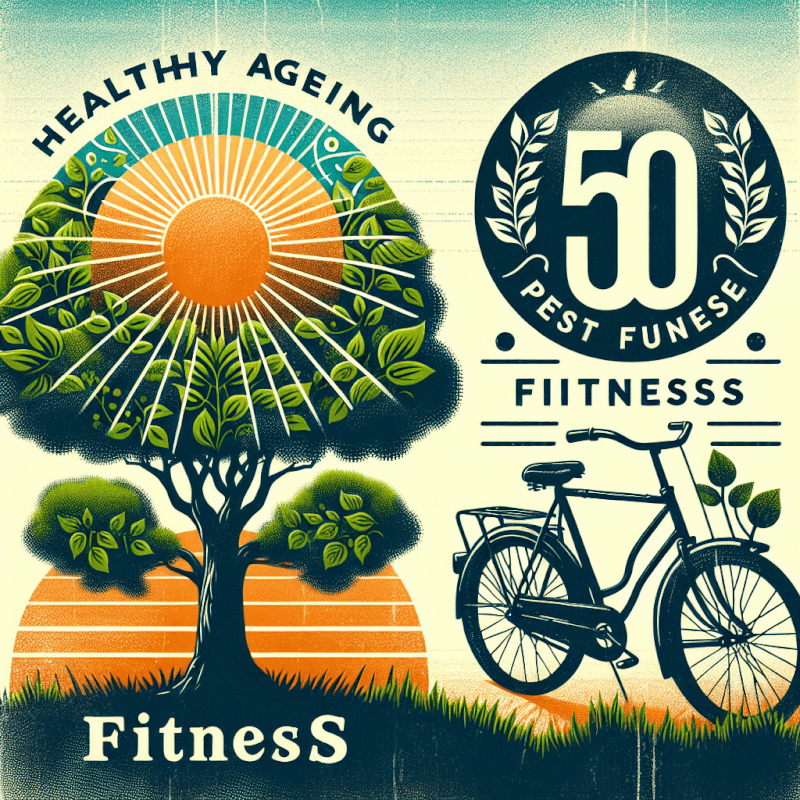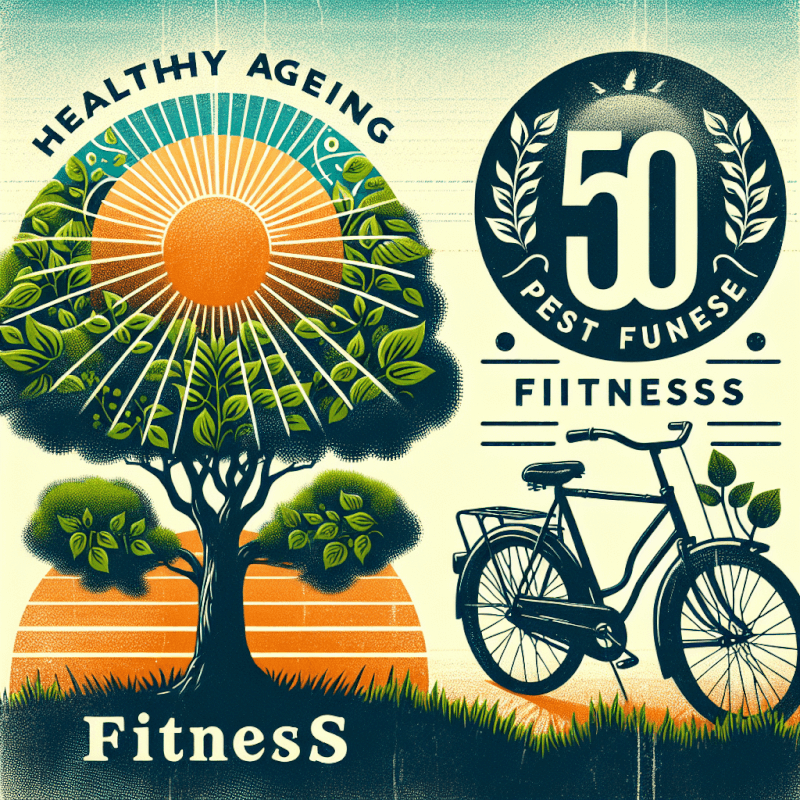Are you over 50 and looking to improve your fitness? In this article, we will explore some practical tips to help you get in shape after 50. As we age, it can become more challenging to maintain our physical health, but it’s never too late to start. Whether you’re a beginner or have some previous fitness experience, these strategies will provide you with the guidance and motivation you need to take control of your health and get back in shape. So let’s get started on this exciting journey to a healthier and stronger you!

Setting realistic goals
Determining your current fitness level
Before embarking on a fitness journey after 50, it is important to assess your current fitness level. This will help you understand where you stand and create a starting point for setting realistic goals. By evaluating your strength, endurance, flexibility, and balance, you can have a clear picture of what areas you need to focus on and track your progress effectively.
Identifying your personal fitness goals after 50
Once you have determined your current fitness level, it is time to identify your personal fitness goals. These goals may vary for each individual, but they should be specific, measurable, achievable, relevant, and time-bound (SMART). Whether your aim is to lose weight, improve cardiovascular health, increase muscle strength, or enhance flexibility, having well-defined goals will keep you motivated and help you stay on track.
Setting SMART goals
Setting SMART goals is crucial for success in any fitness journey, especially after 50. Make your goals specific by clearly stating what you want to achieve. For example, instead of saying “I want to be more fit,” specify “I want to be able to complete a 5-kilometer run.” Make them measurable by setting tangible targets that you can track, such as completing a certain number of push-ups or reducing your waist circumference. Ensure they are achievable by considering your current fitness level and any limitations you may have. Make them relevant to your overall well-being and prioritize what matters most to you. Finally, set a timeframe for achieving your goals to create a sense of urgency and keep you focused.
Making dietary changes
Consulting with a healthcare professional
When making dietary changes, it is essential to consult with a healthcare professional, such as a general practitioner or a registered dietitian. They can provide personalized advice based on your health history, current medications, and any specific dietary restrictions you may have. A professional can also help you develop a balanced and nutritious eating plan that is tailored to your needs and goals.
Evaluating your current eating habits
To make positive dietary changes, it is crucial to evaluate your current eating habits. Keep a food diary for a few days to gain insight into your overall food choices, portion sizes, and nutrient intake. Identify areas where you can make improvements, such as reducing processed foods or increasing your consumption of fruits and vegetables. By understanding your current habits, you can make more informed choices and gradually transition to a healthier eating pattern.
Choosing nutrient-dense foods
As you age, your body’s nutritional needs may change. It is important to choose nutrient-dense foods that are packed with vitamins, minerals, and essential nutrients. Opt for a variety of fruits, vegetables, whole grains, lean proteins, and healthy fats. These foods provide valuable nutrients while helping to manage weight, maintain muscle mass, support bone health, and reduce the risk of chronic diseases.
Managing portion sizes
Portion control plays a significant role in maintaining a healthy weight and managing energy intake. As metabolism tends to slow down with age, it is important to be mindful of portion sizes and avoid overeating. Use smaller plates and bowls, listen to your body’s hunger cues, and practice mindful eating. Pay attention to the nutritional labels of packaged foods, and be aware of portion recommendations to ensure you are consuming appropriate amounts.
Staying hydrated
Proper hydration is essential for overall health, especially during exercise. As you age, your sense of thirst may diminish, making it important to consciously stay hydrated throughout the day. Drink an adequate amount of water and include hydrating foods in your diet, such as fruits and vegetables with high water content. Avoid excessive consumption of sugary beverages and alcohol, as they can dehydrate the body. Remember to listen to your body and drink water before, during, and after physical activity to maintain optimal hydration levels.
Incorporating cardiovascular exercises
Selecting low-impact activities
When incorporating cardiovascular exercises into your fitness routine after 50, it is beneficial to choose low-impact activities that put less stress on your joints. Activities such as walking, swimming, cycling, and using elliptical machines are gentle on the body while still providing excellent cardiovascular benefits. These exercises help improve heart health, increase endurance, and burn calories without causing excessive strain on the joints.
Starting with moderate-intensity workouts
If you have been inactive for a while, it is recommended to start with moderate-intensity workouts for cardiovascular fitness. Aim for a target heart rate range of 50% to 70% of your maximum heart rate. This intensity level promotes endurance and cardiovascular health without overwhelming your body. Start slowly and gradually increase the duration and intensity of your workouts as your fitness level improves.
Establishing a regular exercise routine
To make cardiovascular exercise a habit, it is essential to establish a regular exercise routine. Set aside dedicated time slots for your workouts and treat them like important appointments. Consistency is key when it comes to reaping the benefits of cardiovascular activity. Aim for at least 150 minutes of moderate-intensity aerobic exercise per week, spread out over several days. Breaking it down into smaller sessions can be more manageable, especially if you are new to exercising after 50.
Increasing exercise duration and intensity gradually
As your fitness level improves, it is important to gradually increase the duration and intensity of your cardiovascular exercises. This progressive approach helps to prevent injuries and allows your body to adapt. Slowly increase your workout time and challenge yourself with interval training, where you alternate between higher and lower intensities. Be mindful of any signs of excessive fatigue or strain and adjust your routine accordingly. Remember, it’s a marathon, not a sprint, so be patient and allow yourself time to progress gradually.
Strength training for muscle endurance
Understanding the benefits of strength training
Strength training is an essential component of a well-rounded fitness program, especially after 50. It helps increase muscle mass, improve bone density, enhance metabolism, and maintain overall strength and functionality. Engaging in strength training exercises can help you perform daily activities more easily, reduce the risk of injury, and improve your overall quality of life.
Working with a qualified fitness professional
When starting with strength training, it is advisable to work with a qualified fitness professional, such as a personal trainer or an exercise physiologist. They can guide you through proper technique, alignment, and progression, ensuring that you perform exercises safely and effectively. A professional can design a customized program that targets your specific needs and takes into account any existing health conditions or physical limitations.
Starting with light weights and proper form
For beginners or those returning to strength training after a long hiatus, it is important to start with light weights and focus on proper form. This approach allows your muscles and joints to adapt gradually without excessive strain. Choose weights that challenge you but still allow you to perform exercises with correct technique. Do not forget to warm up before each session to prepare your muscles and joints for the upcoming workout.
Targeting major muscle groups
To achieve overall muscle endurance, it is important to target major muscle groups in your strength training routine. This includes exercises that engage the chest, back, shoulders, arms, legs, and core. Incorporate compound exercises that work multiple muscle groups simultaneously, such as squats, lunges, push-ups, rows, and overhead presses. Vary your exercises to keep your routine interesting and challenge your body in different ways.
Gradually increasing weights and repetitions
As you become more comfortable with strength training and your muscles adapt, gradually increase the weights and repetitions. This progressive overload helps to continue challenging your muscles and promoting muscle endurance. Aim for two to three sets of 8 to 12 repetitions for each exercise. If you can easily complete the desired number of repetitions with proper form, it may be time to increase the weight slightly. Remember to rest between sets to allow for proper recovery.

Flexibility and balance exercises
Importance of flexibility and balance training
Flexibility and balance training are crucial components of any well-rounded fitness routine, especially as you age. Maintaining flexibility helps improve joint mobility and range of motion, while balance exercises enhance stability and reduce the risk of falls. Being flexible and having good balance can significantly improve daily activities and overall functional fitness.
Incorporating stretching into your exercise routine
To improve flexibility, it is important to incorporate stretching exercises into your regular exercise routine. Stretch major muscle groups after each workout to help maintain or increase joint flexibility. Focus on static stretches, where you hold a comfortable stretch for about 30 seconds without bouncing. Stretching should be done when your muscles are warm to prevent injury, so consider doing it at the end of your exercise session.
Trying yoga or tai chi
Yoga and tai chi are excellent options for improving flexibility and balance while offering many additional benefits. Both practices focus on controlled movements, deep breathing, and mindfulness. Yoga combines flexibility, strength, and balance, with poses that can be modified to suit different abilities. Tai chi, on the other hand, is a gentle martial art that consists of slow, flowing movements that help enhance balance, coordination, and overall body awareness.
Using stability balls or resistance bands
Incorporating stability balls or resistance bands into your fitness routine can further enhance flexibility and balance. Stability balls can be used for exercises that challenge your core stability and improve balance. They can also be used for stretching exercises that target different muscle groups. Resistance bands offer a low-impact way to increase strength and flexibility. These versatile tools can be used in various exercises to engage multiple muscle groups and improve overall body control.
Maintaining an active lifestyle
Incorporating physical activity in daily life
Apart from scheduled exercise sessions, it is important to incorporate physical activity into your daily life. Look for opportunities to move more throughout the day, such as taking the stairs instead of the elevator, parking farther away from your destination, or going for short walks during breaks. These small changes can add up and contribute to your overall activity level.
Getting involved in recreational activities
Engaging in recreational activities is a great way to stay active while enjoying yourself. Join a local sports league, try swimming, cycling, dancing, or golfing. These activities not only provide physical benefits but also offer social interaction and mental stimulation. Explore different options and find activities that you enjoy, as this will make it easier to maintain an active lifestyle in the long run.
Exploring outdoor activities
Nature offers countless opportunities for physical activity, so take advantage of the great outdoors. Go for hikes, bike rides, or nature walks in parks or nature reserves. Explore kayaking, paddleboarding, or gardening. These outdoor activities not only provide unique exercise experiences but also expose you to fresh air, sunlight, and the beauty of the natural world.
Using pedometers or fitness trackers
Pedometers and fitness trackers can be helpful tools for tracking your daily activity levels and motivating you to move more. These devices can measure the number of steps you take, the distance you cover, and even your heart rate. Set goals for yourself, such as reaching a certain number of steps per day, and track your progress. Many fitness trackers also offer reminders to move or send alerts if you have been sedentary for too long.

Prioritizing rest and recovery
Importance of rest and recovery after workouts
Rest and recovery are often overlooked but are essential aspects of any fitness routine, especially as you age. Giving your body adequate time to recover after workouts allows it to repair and rebuild muscle tissue, replenish energy stores, and reduce the risk of overuse injuries. Without proper rest, you may experience fatigue, decreased performance, and increased susceptibility to illness.
Getting enough sleep
One of the most important aspects of rest and recovery is ensuring you get enough sleep. Sleep plays a crucial role in the body’s healing and repair processes. Aim for seven to eight hours of quality sleep per night. Create a relaxing bedtime routine, avoid stimulants like caffeine close to bedtime, and ensure your sleep environment is comfortable and conducive to restful sleep. If you have difficulty sleeping, consider implementing relaxation techniques or speak with a healthcare professional for guidance.
Listening to your body’s signals
Your body knows best when it comes to rest and recovery. Listen to the signals it sends you. If you experience excessive fatigue, muscle soreness, or prolonged feelings of lethargy, it may be a sign that you need additional rest. Allow yourself rest days in your fitness routine, and don’t hesitate to take a break or modify your workouts if your body needs it.
Incorporating active recovery days
Active recovery days can be beneficial for promoting blood flow, reducing muscle soreness, and enhancing overall recovery. Engage in light activities such as stretching, gentle yoga, or leisurely walks on your rest days. These activities help loosen tight muscles, improve flexibility, and stimulate circulation without putting excessive stress on your body.
Avoiding overtraining
While it is important to challenge yourself, it is equally important to avoid overtraining. Overtraining occurs when you do not allow your body sufficient time to recover between workouts, leading to fatigue, decreased performance, and an increased risk of injury. Pay attention to signs of overtraining, such as persistent muscle soreness, decreased motivation, and an elevated resting heart rate. If you suspect overtraining, take a break, reassess your routine, and consider consulting a fitness professional to ensure you are staying within healthy limits.
Seeking medical advice
Consulting your doctor before starting new exercise
Before starting any new exercise program, especially if you are over 50 and have pre-existing health conditions, it is important to consult your doctor. They can assess your overall health, review any medications you may be taking, and provide guidance on the type and intensity of exercise that is safe for you. Your doctor can also address any specific concerns or provide recommendations based on your individual circumstances.
Discussing any pre-existing conditions or concerns
During your consultation, be sure to discuss any pre-existing medical conditions or concerns you may have. This includes issues such as high blood pressure, diabetes, heart disease, joint problems, or previous injuries. Your doctor can provide valuable advice on how to adapt your exercise routine to accommodate any existing limitations or medical considerations. Being proactive in discussing your concerns will ensure that you exercise safely and effectively.
Monitoring blood pressure and heart rate
If you have high blood pressure or heart-related issues, it is important to monitor your blood pressure and heart rate during exercise. This can help you determine the appropriate intensity and ensure you are exercising within safe limits. Consider investing in a heart rate monitor or using the built-in heart rate monitor on fitness trackers to track your heart rate during workouts. Take note of any abnormal readings and consult your healthcare professional if you have concerns.

Staying motivated
Finding an exercise buddy or joining a group
Exercising with a friend or joining a group can greatly enhance your motivation and enjoyment of physical activity. Having a workout buddy holds you accountable, provides encouragement, and makes exercising more fun. You can meet for regular workouts, try new activities together, or even participate in group fitness classes. Being surrounded by like-minded individuals who share similar goals can boost your motivation and help you stay committed to your fitness journey.
Setting up a rewards system
Reward yourself for reaching milestones and achieving your fitness goals, no matter how small. Set up a rewards system that provides incentives to keep going. Treat yourself to something you enjoy, such as a massage, a new workout outfit, or a fun day out. Celebrating your achievements can fuel your motivation and make your fitness journey more enjoyable.
Tracking progress and celebrating achievements
Keep track of your progress to stay motivated and celebrate achievements along the way. Use a fitness journal, a smartphone app, or a fitness tracker to record your workouts, monitor your improvements, and track your goals. Seeing your progress in numbers or visuals can be highly motivating. Celebrate milestones, such as running a longer distance or lifting heavier weights, and acknowledge the progress you have made. Self-recognition and positive reinforcement will keep you motivated and help you maintain a positive mindset.
Experimenting with different exercise routines
Variety is the spice of life, and it applies to fitness as well. Keep your workouts interesting by experimenting with different exercise routines. Try new activities, such as dance classes, Pilates, or hiking. Incorporate different types of exercises like high-intensity interval training (HIIT) or circuit training. Changing up your routine not only prevents boredom but also challenges your body in different ways, ensuring continuous progress and motivation.
Adapting to age-related changes
Understanding common age-related fitness challenges
As you age, there are several common fitness challenges that you may encounter. These include decreased muscle mass, reduced bone density, slower metabolism, and joint stiffness. Understanding these challenges can help you tailor your exercise routine to address them effectively.
Modifying exercises for joint health
To protect your joints and maintain joint health, it is important to modify exercises to avoid excess stress or impact. Consider low-impact alternatives to high-impact exercises, such as cycling instead of running or using an elliptical machine instead of aerobics. Incorporate exercises that promote joint mobility, such as gentle stretching, yoga, or swimming. Be mindful of any discomfort or pain during exercise and adjust accordingly to prevent further joint stress or injury.
Incorporating balance exercises for fall prevention
With age, maintaining balance becomes increasingly important for fall prevention. Incorporate balance exercises into your routine to improve stability and reduce the risk of falls. These exercises can include standing on one leg, heel-to-toe walk, yoga poses like tree pose or eagle pose, or using balance boards. Start with simple exercises and progress at your own pace. Balance exercises not only enhance physical stability but also promote better posture and body awareness.
By following these guidelines and incorporating them into your daily life, you can embark on a successful journey to get in shape after 50. Remember, consistency, patience, and a positive mindset are key. Listen to your body, seek professional guidance when needed, and celebrate your progress along the way. With determination and the right approach, you can achieve your fitness goals and enjoy a healthy, active life at any age.



